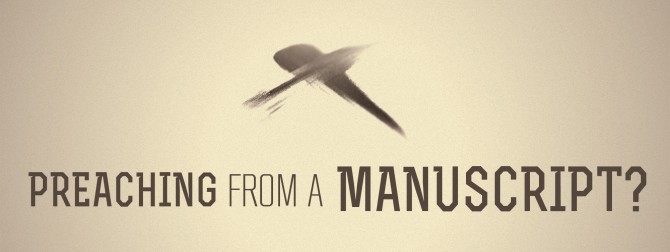A few months ago I offered three advantages a manuscript will bring for the ordinary preacher: clarity, sensitivity, and usability.
If one decides preaching from a manuscript is best for his ministry, the decision making is not done. He must then settle on exactly how to format his manuscript: font choice, size, and color being a few things that come to mind.
A DIVERSITY OF EXAMPLES
Several years ago Josh Harris ran a fascinating and edifying series on his blog called, “Preaching Notes (Round 1, Round 2)”. He asked a few well-known preachers to send along whatever resource they took into the pulpit on a recent Sunday: manuscript, outlines, or stick note. Here are a couple examples from men that manuscript their sermons:
- Mark Dever
- David Platt
- Kevin DeYoung
- While I am not sure it is “properly” a manuscript, Tim Keller’s method is nonetheless amazing!
Clearly no two manuscripts are alike and, in many ways, they appear to reflect the preacher’s individual personality. Some have hand-written annotations, while others are more keen on employing font formatting.
A COLOR-CODED SCRIPT
If Josh ever comes along and ask for my manuscript – not in this life! – you’d see a plethora of color. My manuscripts are color-coded, which means:
- Any Scripture quotation is in blue
- Any extra-biblical quotation is in green
- Any illustration, analogy, or metaphor is in red
- Any application is in orange
- The gospel call to unbelievers is in maroon
- Any exposition or explanation is in black
I’ve found color-coding the manuscript to be uniquely helpful in preparation and delivery. When I am preparing a sermon I can generally get a sense of the content’s development by the color. For example, if look at an entire page without any orange (application) or red (illustration, analogy, etc.) it’s likely my exposition of certain points is far too long-winded. Or if I look at a page and see half of it in red, I have fallen off the other side of the horse and the illustrations are taking over. What I am looking for is appropriate balance in color, mostly black and blue, with some subset of color shading each page (my sermons generally run six pages long).
The color-coding is also incredibly useful during sermon delivery. I am a visual learner who functionally memorizes his manuscript. The color helps me quickly situate my mind on any given page of the sermons so that I rarely need to search for particular content. This is particularly useful when I want to read a quote; all I need to do is seen green on the page and start reading. My goal in all this is that my use of a manuscript never becomes obtrusive to my delivery.
Another benefit is that I often do not have to read any specifics of the text the get my homiletical bearings, but only see the color to know what’s coming next. So in the screen-shot above, if I look down when making the point about the Lord’s Supper being an eschatological announcement, I will see a chunk of red and orange coming and thus immediately know the exposition is followed by illustration and application. The color alone is often sufficient to summon the individual parts to memory.
But don’t just take my word for it. If you are a manuscript man feelingly a stuck on black and white, take a dance on the wild side and try color-coding your content. You might be surprised how useful it is.


